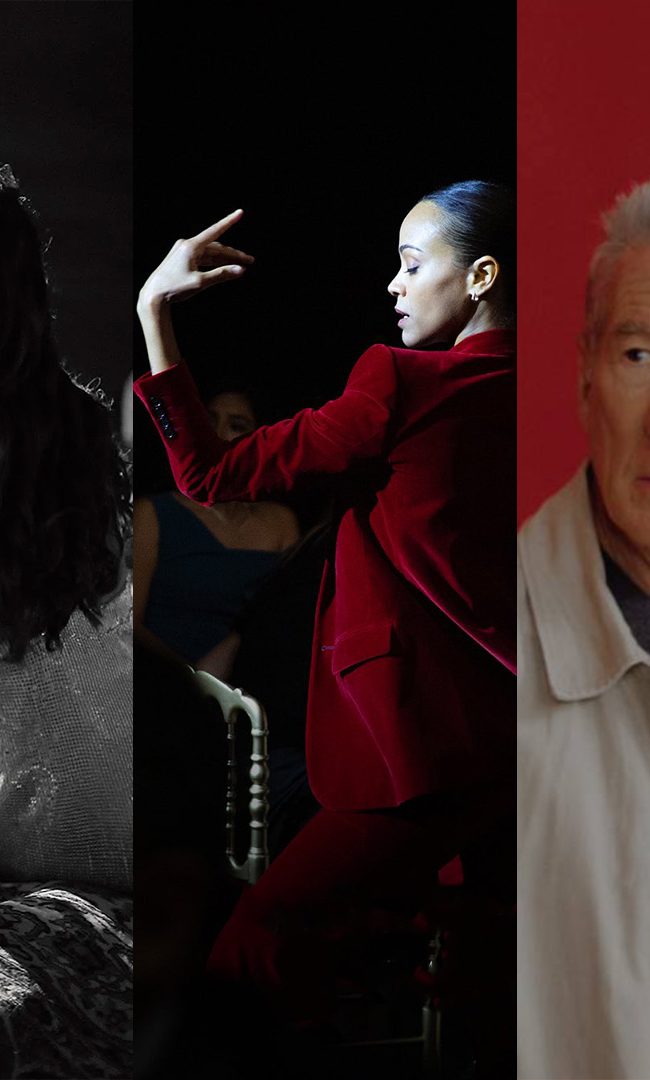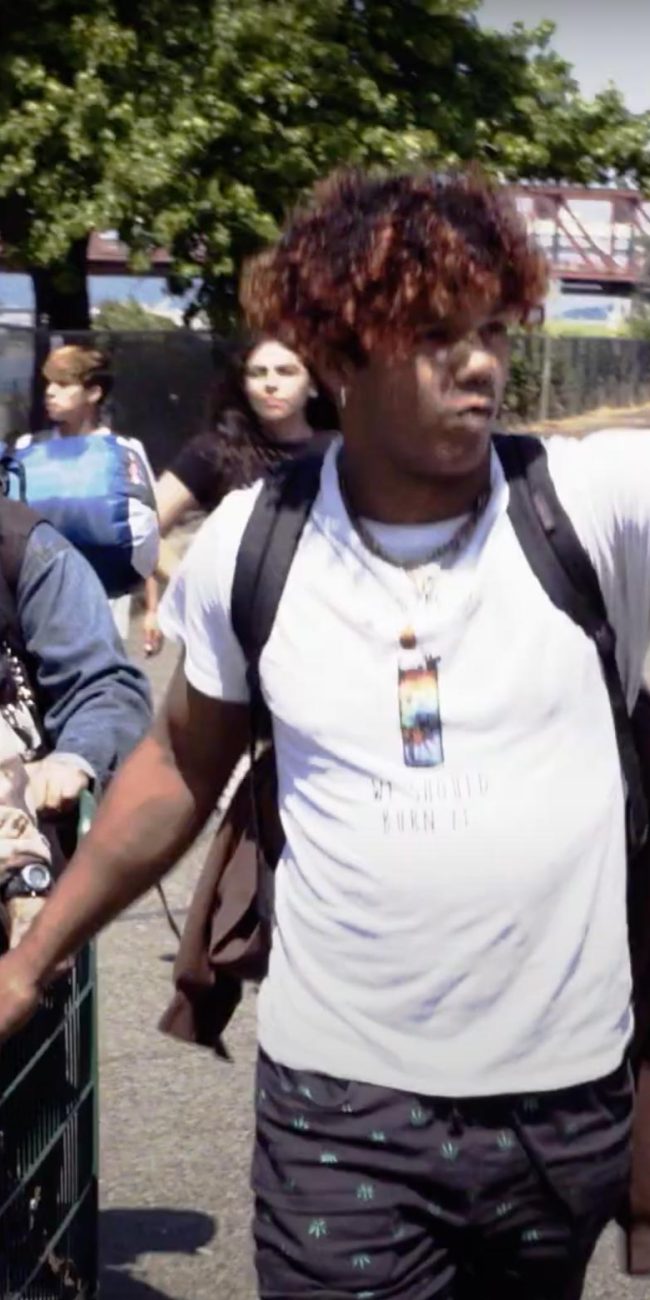A Conversation With Sean Baker and Dree Hemingway (STARLET)
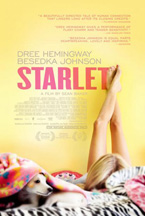 [Starlet is now available on DVD and Blu-ray.]
[Starlet is now available on DVD and Blu-ray.]
Though Starlet couldn’t be more different than Sean Baker’s recent micro-budget gems Take Out and Prince of Broadway, it once again proves that he’s one of independent cinema’s shining lights. This California-set tale feels like several movies in one, yet Baker somehow manages to unify them. A beautiful 20-something girl, Jane (a knockout performance by Dree Hemingway), forms an unlikely bond with an 80-something woman, Sadie (outstanding first-timer Besedka Johnson). When Jane’s not easing her way into Sadie’s life with her adorable doggie Starlet, she makes money by working in the adult film industry. Here is where Baker’s commitment to authenticity takes the film to an unexpectedly frank level. Shot digitally with vintage Lomo lenses, Starlet has a timeless cinematic richness that puts most low-budget indies to shame. And though it does indeed “go there,” it is as sweet-natured a film as you could hope to encounter. To compare it to Driving Miss Daisy might sound like an insult, but Starlet has an accessibility and warmth that cannot be denied.
After some initial concern that the brief-but-graphic content contained within the film might hurt its chances for distribution, it nonetheless receives a deserved theatrical release on November 9, 2012, thanks to Music Box Films (go here for screening information). Many months ago—the morning after Starlet‘s world premiere at the 2012 SXSW Film Festival, in fact—I sat down with Baker and Hemingway at The Highball to discuss their deeply impressive achievement.
***DISCLAIMER: WHILE THERE AREN’T NECESSARILY OVERT “SPOILERS” CONTAINED WITHIN THIS CONVERSATION, IT DOES PERHAPS HOVER IN THE SPOILER BALLPARK, SO PROCEED WITH CAUTION!***
Hammer to Nail: At the Q&A yesterday, you were talking about the need to have a scene that gets graphic, the film deserves that and it wouldn’t have been truthful to not go in that direction. Which leads me to wonder if you had initially envisioned casting an actress who would cross that line?
Dree Hemingway: I’m sure that he thought the actress he hired would do that. And we talked about it too a little bit, but when it gets down to it, when there’s penis and vagina happening… it’s intense.
Sean Baker: To tell you the truth, this is the first time I’m discussing this. We were going to hire an adult performer as the lead. And were looking for somebody who had that Jane persona. And we found somebody and recorded her for a little while, and actually did some rehearsing with her, but it just didn’t work, for many reasons. So then we decided, let’s go after somebody who has had formal training, has an acting background, and we decided right there and then that we were still going to have that scene. We had already made connections in the adult film world, and we were still going to have that scene done with a body double, but we were going to cast Jane with an actor, who may or may not be comfortable doing that.
H2N: And then, how did you guys connect? Had you known of Dree?
 SB: Not at all, no. We were actually searching for quite a while. And it was her manager, Allan Mindel, who reached out to me, because he saw—we were also desperately looking to cast the Sadie role—and he saw that casting call and asked us if we had cast for the 20-year-old yet, and if we hadn’t if we’d be interested in considering Dree, and I had no idea Dree was even interested in acting. And immediately I checked out every YouTube interview there was of Dree…
SB: Not at all, no. We were actually searching for quite a while. And it was her manager, Allan Mindel, who reached out to me, because he saw—we were also desperately looking to cast the Sadie role—and he saw that casting call and asked us if we had cast for the 20-year-old yet, and if we hadn’t if we’d be interested in considering Dree, and I had no idea Dree was even interested in acting. And immediately I checked out every YouTube interview there was of Dree…
DH: They’re all retarded. [All laugh]
SB: But I was intrigued and I saw that she has an appealing personality. So it was there that I knew I had to speak with her. And we got on a video Skype call for like 30 minutes, right?
DH: It was more like an hour. We were on there for an hour. It was good, though. It was me in my apartment, I’m like, “Hey!” going over the movie and talking about how I felt Jane was and this and that. I was so passionate about the script. I hadn’t read a script in a while that had grabbed me like that, and I instantly fell in love with it. And I was so excited to meet Sean on Skype, and it was like we were old friends talking for some reason.
SB: Yeah. By the end of the call I asked her to be in the film.
H2N: That’s great to hear. You knew right away.
SB: Yeah.
H2N: Your process seems to create an atmosphere that elicits performances from actors and non-actors both that are so real and natural.
DH: That’s what’s so good about it. The nice thing about the whole movie is that I think it’s really real. There are weird moments and I’ve always been in tune with “fakeness,” if you will, and I wanted everything to feel real and raw.
H2N: Had you seen Take Out and Prince of Broadway before you met him? Did you do that sort of research?
DH: No. I’m the worst. The nice thing about Allan is he won’t ever send me anything that he hasn’t read and fallen in love with. And I trust him because he helped produce My Own Private Idaho and a bunch of different movies, and he just has a really keen eye for what will do well. And he sent me this script, as I was saying, and I fell in love with it. I loved the fact that it was improvisational as well, ‘cause it was a very short script.
H2N: Was it just written out as beats or did you write actual dialogue?
SB: We had dialogue. [The script] was around 70 pages. But it was underwritten in terms of detail. So, when our line producer started breaking it down he was like, “Oh boy, this could be over two hours long.” Which, actually, the first cut was over two hours. Because of the amount of locations and stuff like that. But the dialogue, we did the same thing we did with Prince, basically, which is we provided dialogue but then they could throw it out the window if they wanted to. And then there were some scenes, such as the pot smoking scene on the couch, which was more about a theme. I would tell James Ransone to study up on Sun Tzu the night before…
DH: And he’d come in and just rant.
H2N: Did he beef up for the role?
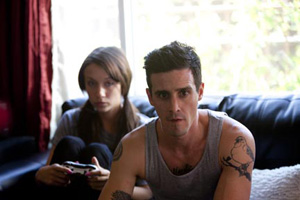 SB: No, he beefed up for Generation Kill, I think, and he’s retained it.
SB: No, he beefed up for Generation Kill, I think, and he’s retained it.
DH: He’s quite athletic and very healthy as well.
SB: He’s great. I’m so happy with the whole cast.
H2N: When you talk about feeling it out and improvising, did you have a production schedule that would allow room for that type of discovery and play, like taking a whole day to shoot that couch scene when you knew it would only last a few minutes in the finished film?
SB: Oh yeah.
H2N: Then did you still do rehearsing before shooting or did you allow that to work itself out while you were shooting?
SB: Did we?
DH: No.
SB: I did a little bit of rehearsing with Besedka and Stella (Maeve).
DH: I did my own hair and makeup, so I’d show up ready, and then we’d just kind of snap into it when camera and sound were ready and go from there.
SB: Because I had a little more time actually with them, you were flying in, so there wasn’t much prep time. I had a little more time with the other actors. Karren (Karagulian) and Stella, I put together in a room together to do that whole Renegade scene in which they have that fight.
H2N: One thing that really jumped out at me yesterday, you know that I watch a lot of indie movies, but also in light of Take Out and Prince, you would expect this movie to have a hyper-handheld, pseudo-doc camera style, but what you do differently this time, and I think what distinguishes it, is that you seemed to embrace a much more controlled, formal framing. At what point did you make that very wise decision?
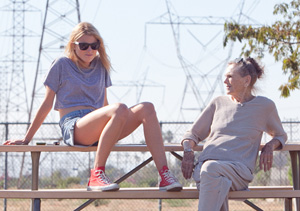 SB: We knew that there was going to be a certain percentage that was handheld, a certain percentage that were composed shots.
SB: We knew that there was going to be a certain percentage that was handheld, a certain percentage that were composed shots.
DH: A lot of it was handheld, although it was steadily handheld.
SB: But the thing is, we were also using these very heavy lenses, and so the camera was extremely heavy, and suddenly it was like holding an Arri-SR on our shoulders. It was as heavy as a 35mm camera.
DH: You’d put down the camera and just be sweating and panting.
SB: So maybe that dictated it a little bit? But also, I was using scope for the first time, and I wanted to take advantage of that with trying to get some nicely framed stuff, in which I was using the right and left side of the frame.
DH: The nice thing is I think it looks like film. Even Allan was saying, “I can spot digital from anywhere, and I couldn’t pick that out.”
H2N: Another factor is the color. I’m not sure how much correction you did, but the colors are very muted, and I think a lot of digitally shot movies have a hyper-saturated commercial crunch, yet this was beautifully muted. Almost like what Harris Savides did with Greenberg, giving it more of a California Split or The Long Goodbye feel. It’s not hazy, necessarily, it’s just a more muted palette.
SB: Yeah. Desaturated.
DH: I think your whole thing was wanting a timeless piece, where you can watch it and it’s not set in any specific time.
SB: The one time we do saturate it in the film is every time that Valley sun gets into the lens, I allowed it to come up, with the orange and stuff like that. If you watch it again, you’ll see that it actually gains in color. By the end, we’re almost full saturation.
H2N: Yeah, there was a shot towards the end, I think it was when she walks out of the house?
SB: That’s when we did the full saturation.
H2N: But even then, while it had a pop, it just didn’t feel soaked in digi-goo. What I love about your movies, Sean, and what I think separates you from a lot of indie filmmakers is, like you said Dree, his commitment to naturalism and believability in every moment. But what’s perhaps more important is that you always seem to include a narrative hook that makes the work immediately accessible. Very early on this film, money falls out of a vase. That seemingly simple gesture automatically lifts your movie beyond a more familiar indie in which the motivation is to simply “show these people how they are” or whatever. I know you’re into world cinema and art films, but you seem to have a refreshing chip built into you that wants to entertain as much as enlighten.
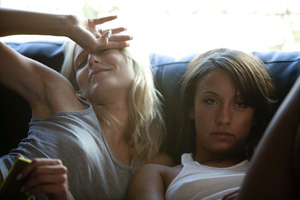 SB: My first instinct was to make a small verite film following a girl around one day, a day in which she wasn’t working, and she loses her dog, and by the end she finds her dog, and that’s the movie! But in talking to my co-writer, Chris Bergoch, he’s like, “You know what? What I liked about your other two movies is that you gave personal stories to people who normally don’t get that.” And I was like, “Oh, cool, alright!” And then he was like, “Let’s make it a little more plot driven and let’s give a story to somebody who normally doesn’t [get that].” For example, usually when films are made about this industry, it’s all about the industry. It’s just like, this is the girl’s life, porn defines her, this is all we’re gonna show. And we wanted to do something completely different. Give a story that maybe Hollywood would give to a barista or a student, give this story to her.
SB: My first instinct was to make a small verite film following a girl around one day, a day in which she wasn’t working, and she loses her dog, and by the end she finds her dog, and that’s the movie! But in talking to my co-writer, Chris Bergoch, he’s like, “You know what? What I liked about your other two movies is that you gave personal stories to people who normally don’t get that.” And I was like, “Oh, cool, alright!” And then he was like, “Let’s make it a little more plot driven and let’s give a story to somebody who normally doesn’t [get that].” For example, usually when films are made about this industry, it’s all about the industry. It’s just like, this is the girl’s life, porn defines her, this is all we’re gonna show. And we wanted to do something completely different. Give a story that maybe Hollywood would give to a barista or a student, give this story to her.
H2N: In your Q&A yesterday, you talked about having already been familiar with the industry, from the casting work you did in Greg the Bunny. I guess it might sound silly to ask a “research” question, so I guess what I’m wondering is if this particular character was based on a specific person or a group of people?
SB: Yeah, yeah, you’ll see a list of consultants at the end.
DH: There was also a lot of… Stella, who does a lot of method acting, would go and hang out with all the porn stars. Pick them up from work, watch them do scenes, hang out with them. She really pushed herself into that industry. Whereas I attempted to watch some porn, it freaked me out, that’s not my thing at all. [laughter] I decided I had to make it my own, in my own way.
H2N: Watching porn is also the wrong research because that’s not the point of the character, right?
SB: Yeah.
H2N: Dree, do you know LA well? Were you at least comfortable with the character in that broader regard?
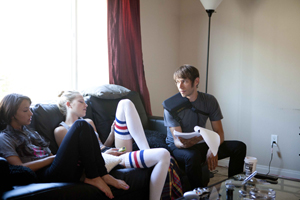 DH: I was born in Idaho, and grew up and went to high school in the Westlake Village area. So this was not far from that. I mean, I knew the Valley area. To be honest, I’m very, very comfortable in Los Angeles. But I think I’m very sensitive to weird things. Like, when we were shooting in that house, it was a real porn star’s house. Very draining. Days and days and days. There’s like weird scenarios and eeriness and secrecy going on.
DH: I was born in Idaho, and grew up and went to high school in the Westlake Village area. So this was not far from that. I mean, I knew the Valley area. To be honest, I’m very, very comfortable in Los Angeles. But I think I’m very sensitive to weird things. Like, when we were shooting in that house, it was a real porn star’s house. Very draining. Days and days and days. There’s like weird scenarios and eeriness and secrecy going on.
SB: It’s a real model house. Both houses. The second was just a more elaborate model house. But there were girls, we were actually shooting in their room and they’d say, “Oh, have fun.”
DH: They were sweethearts. I think that’s what got me the most. I wanted to kind of… help them.
SB: I know that we shot that big blow-out scene, that scene where Melissa confronts Jane at the end of the film, and that was after weeks of us shooting in there, and it was extremely intense.
DH: I was shaking.
SB: By that time, the emotions had gotten to everybody.
[At this point, I stopped recording since our time was up, but Sean wanted to make one final comment.]
SB: There was one performer, in particular, who gets consulting credit on this film, Tanner Mayes, who Melissa’s character is sort of based on. I mean, Tanner is wonderful, kind, the biggest heart, but she had a moment in her life where things weren’t going so well. Now she’s completely clean and things are going better for her, but she did have a blowout that was very similar to the one we shot at Renegade, and we approached her and said, “We want to recreate that,” and she was okay with it. “As long as you give me consulting credit on the film.” So there were a few different people in the industry that we sort of modeled our characters after, but that was one in particular.
— Michael Tully








